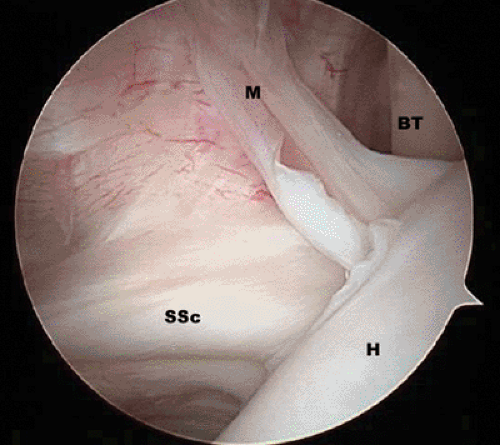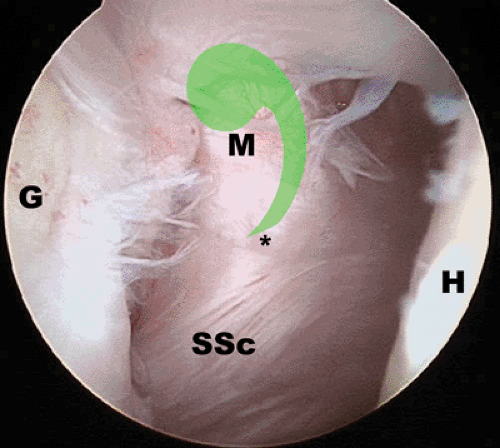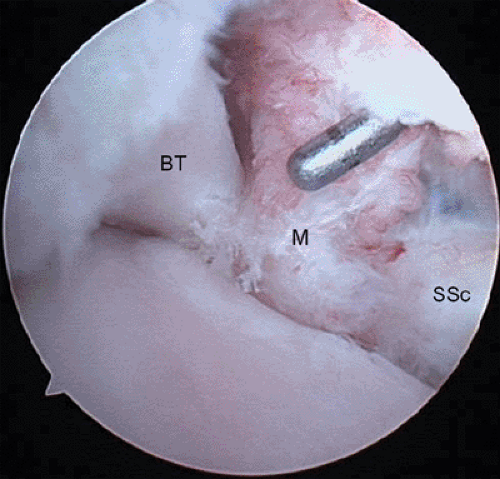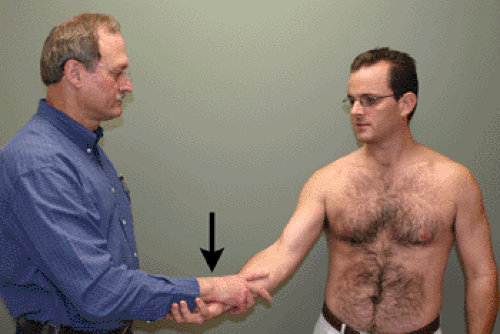Biceps Tendon
Paul C. Brady MD
Keith D. Nord MD, MS
Stephen S. Burkhart MD
The long head of the biceps (LHB) originates at and around the supraglenoid tubercle. Although it is intra-articular, it is extrasynovial.
Although acute ruptures of the LHB do occur, LHB ruptures are more commonly the result of chronic biceps tendonitis.
There is such a close association between subacromial impingement and biceps tendonitis that the two conditions have closely overlapping symptoms. They can be difficult to distinguish and more often than not occur in tandem.
The hallmark of biceps tendon related pathology is point tenderness in the bicipital groove.
Given the close relationship between biceps tendon pathology and concomitant subacromial impingement and/or rotator cuff tear, it is important to examine the remainder of the shoulder. Specific tests for range of motion, impingement, rotator cuff integrity, and instability should be performed.
Ultrasound and arthrography are equally effective for the diagnosis of biceps tendon and rotator cuff problems, but ultrasound is superior when evaluating the biceps tendon.
Complications of the biceps tenotomy primarily involve the anticipated 21% risk of a “Popeye” deformity of the biceps muscle as it retracts distally. Arthroscopic biceps tenotomy is otherwise a relatively safe procedure with very minor risks of infection, blood clots, or neurovascular injury. Biceps tenodesis may be appropriate for younger, more active patients to maximize shoulder and elbow function.
The long head of the biceps (LHB) tendon … what does it do? What symptoms does it cause? What is the etiology of its pathology? What is the best treatment of biceps associated disorders? These are just a few of the questions concerning the biceps tendon for which opinions are abundant but firm conclusions are elusive. In our understanding of the shoulder, the LHB is still somewhat of an enigma. There are many beliefs and a plethora of data which provide much information but little clarity on the biceps tendon.
This chapter will attempt to provide a comprehensive overview regarding the biceps tendon. It will discuss both the undisputed aspects such as its anatomy as well as more controversial topics such as its function, pathophysiology, and treatment. The goal is to present a balanced and succinct overview of the biceps tendon and its pathology and treatment.
Anatomy
The anatomy of the LHB has been thoroughly examined and little controversy exists in this realm. The LHB originates at and around the supraglenoid tubercle. Although it is intra-articular, it is extrasynovial. Its blood supply is dependant on the portion of tendon in question. The proximal and middle portions receive blood supply from branches of the anterior humeral circumflex artery and the distal third of the tendon receives nourishment from branches of the deep brachial artery. The blood supply is markedly reduced in the portion of the tendon which slides in the bicipital groove.
Habermayer et al. (1) demonstrated LHB origin from the supraglenoid tubercle in 20% of specimens, origin from the posterosuperior labrum in 48%, and origin from both the labrum and tubercle in 28%. Pal et al. (2) demonstrated the major origin from the supraglenoid tubercle in 25% and from the posterosuperior labrum in 70%. The association between the biceps tendon and the superior labrum was further examined by Vangsness et al. (3) who classified the origin into four types. Type I (22% of specimens) demonstrated origin entirely from the posterior labrum; Type II (33%) demonstrated primarily posterior attachment with small anterior labral component; Type III (37%) demonstrated equal anterior and posterior labral components; and Type IV (8%) demonstrated only anterior labral contribution. The close relationship between the biceps and the labrum was further supported by Cooper et al. (4) who demonstrated an intimate relationship between the collagen fibrils of the two structures.
The length of the tendinous portion of the LHB measures approximately 9 cm and the musculotendinous junction is at the level of the deltoid and pectoralis major insertions. Its shape is relatively flat at its origin, becoming more tubular as it proceeds distally and into the intertubercular groove (5). McGough et al. (5) examined the tensile properties of the LHB and demonstrated that it is weakest at the midpoint— where all his experimental specimens ruptured.
The course of the LHB is from the posterosuperior aspect of the glenoid obliquely over the top of the humeral head. It then enters the bicipital (intertubercular) groove. This groove is formed by the confluence of the lesser tuberosity (anteriorly) and the greater tuberosity (superiorly). Anatomic studies have demonstrated varying depths of the groove (average = 4.3 mm) and varying inclination of the walls of the groove (6). Ueberham et al. (7) described a ridge on the upper portion of the lesser tuberosity (termed a supratubercular ridge) in 45% of anatomic specimens, which was postulated to “push” the biceps anteriorly. Although some authors have suggested that a shallow inclination of the groove predisposes to dislocation (1,8), others have found no such association (6).
The most critical anatomical consideration to understand regarding the LHB is that of its stabilizing structures. Specifically, a thorough understanding of the rotator interval is essential. The rotator interval is the triangular interval bordered superiorly by the anterior margin of the supraspinatus, inferiorly by the superior margin of the subscapularis, and medially by the anterior aspect of the glenoid. Within this triangular space exists anterior glenohumeral capsule as well as the coracohumeral ligament (CHL) and the superior glenohumeral ligament (SGHL). The SGHL and the medial head of the CHL join to form a medial sling for the LHB and this is the major restraint to medial subluxation/dislocation of the LHB (10,11) (Fig 14-1).
The CHL originates from the base of the coracoid process and divides into two bands—a superior band, which inserts into the anterior supraspinatus, and an inferior band whose medial head inserts into the superior subscapularis and then onto the superior aspect of the lesser tuberosity. The SGHL also contributes to this medial sling as it courses from the anterior labrum (just anterior to the biceps origin) and inserts onto the superior aspect of the lesser tuberosity. The fibers of the medial head of the CHL are much more robust and structurally important to the medial sling than the fibers of the SGHL. This sling is critical in preventing the LHB from displacing medially onto the lesser tuberosity. In this way, the sling protects the proximal insertion of the subscapularis from the stresses that would result from a medially displaced LHB.
 Fig 14-1. Posterior view of the right shoulder demonstrating the medial sling (M) of the biceps tendon (BT) and its confluence with the superolateral border of the subscapularis (SSc). |
The medial sling and its relationship to the biceps tendon has been described as “the comma sign” (9). This comma sign is an arthroscopic description of the aforementioned anatomy of the medial sling and was so named because of its arthroscopic appearance. The comma sign consists of the medial head of the CHL and SGHL (medial sling of the biceps) intersecting with the superior border of the subscapularis. Although the comma sign is visible in the absence of pathology, it is much more prominent, recognizable, and useful in the presence of a torn and retracted subscapularis tendon. When the subscapularis is torn from its insertion on the lesser tuberosity, the medial sling of the biceps is also pulled off and its association maintained with the subscapularis. Identification of this comma structure is critical when searching for the subscapularis tendon because it is always located at the superolateral border of the subscapularis tendon (Fig 14-2).
Historically, it was felt that the transverse humeral ligament was the vital structure in regards to retaining the biceps within the bicipital groove (12); however, this view has been challenged (13,14,15). Paavolainen et al. (15) cut the transverse humeral ligament in cadaver specimens but were still unable to dislocate the biceps tendon. Also, Gross
[Ruotolo et al. (16)] reported on a technique of arthroscopic release of the sheath of the biceps tendon. In this technique the transverse humeral ligament was divided yet postoperative dislocation or subluxation of the biceps tendon did not occur. Gross emphasized that the CHL be preserved with this technique to prevent biceps instability.
[Ruotolo et al. (16)] reported on a technique of arthroscopic release of the sheath of the biceps tendon. In this technique the transverse humeral ligament was divided yet postoperative dislocation or subluxation of the biceps tendon did not occur. Gross emphasized that the CHL be preserved with this technique to prevent biceps instability.
Biomechanics
Few would dispute the critical role of the biceps brachii at the elbow joint and its function has been well documented at this position (17). It is with the LHB’s role at the shoulder where the arguments intensify. Many authors have suggested that the LHB has a role in humeral head depression—particularly with shoulder external rotation (18). Andrews et al. (19) observed the biceps arthroscopically while electrically stimulating the biceps muscle and saw lifting of the labrum superiorly and compression of the glenohumeral joint. Likewise Kumar et al. (20) reported significant upward and anterior migration of the humeral head when the LHB was sectioned and then the biceps muscle was electrically stimulated. In another study, however, Lippmann (21) saw no humeral head motion with active biceps contraction.
Electromyography (EMG) studies have also demonstrated varying findings. Basmajian (22) demonstrated that the LHB did have EMG activity during active shoulder flexion. The LHB was estimated to contribute 7% of the power of shoulder flexion (23,24). Jobe et al. (25,26) showed peak biceps activity during follow-through and deceleration in the throwing motion. In separate studies, however, Yamaguchi et al. (27,28) and Levy et al. (29) modified the EMG experiment to control (limit) elbow flexion and both studies showed minimal to no EMG activity during isolated shoulder flexion. Another intriguing EMG finding has been an increase in EMG activity of the LHB in patients with rotator cuff deficiency (30). This increased activity may result in the increased tendon diameter, which was observed by Rowe (31). Overall, although still somewhat controversial, there is some current literature supporting that the LHB has a depressing function in the shoulder and helps stabilize the humeral head in the glenoid. Even so, these effects are not dramatic.
Pathophysiology
Multiple classification schemes have been developed to describe disorders of the LHB tendon. These divisions have been only marginally useful in regards to diagnosis and treatment decisions. More important is to understand the various pathological processes involving the biceps tendon and how to treat each process accordingly. The three biceps tendon pathologies that we will discuss are biceps tendinitis, rupture, and instability. Lesions involving the biceps origin (SLAP lesions) will be discussed in greater detail elsewhere.
Biceps tendinitis has been partitioned into primary tendinitis versus secondary tendinitis. Primary tendinitis involves inflammation of the tendon within the bicipital groove. To be considered primary, no other pathological findings (such as impingement, bony abnormalities within the groove, or biceps subluxation) should be present. It is considered an uncommon condition (32) and should be thought of as a diagnosis of exclusion (33). Habermayer and Walch (34) noted that this diagnosis can only be made during arthroscopy.
Much more common is the condition of secondary biceps tendinitis. As the LHB has an intimate relationship with its adjacent rotator cuff structures—most notably the anterior supraspinatus and superior subscapularis—it is affected by the same forces that produce pathology in these areas. Although subacromial impingement produces undue forces on the anterior rotator cuff, it also compresses the underlying LHB and produces concomitant pathology (and thereby symptoms) in this structure (33,34,35,36,37,38,39). In fact, the impingement upon the LHB worsens as a rotator cuff tear progresses and increased contact between the LHB and the coracoacromial arch occurs.
Another potential cause of secondary biceps tendinitis is the presence of bony anomalies of the proximal humerus. Most commonly these bony anomalies are secondary to malunion or nonunion of a proximal humerus fracture. If a fracture extends into the bicipital groove, significant irritation of the LHB can occur. DePalma and Callery (40) suggested that younger patients with biceps tendinitis are more likely to have groove anomalies such as narrowing or osteophytes, but it is difficult to determine the sequence of events in such conditions. Do the groove anomalies cause the tendinitis or the tendinitis cause resultant groove anomalies?
Biceps Tendon Rupture
Although acute ruptures of the LHB do occur, they are more commonly the end result of chronic biceps tendinitis. Acute ruptures can occur with a violent force placed on the LHB such as with a fall on an outstretched hand. Another traumatic event, which can cause significant damage to the LHB, is rapid deceleration of the arm during throwing activities (41). In this case the deceleratory force can result in trauma to the origin of the LHB resulting in a SLAP lesion. If the force is great enough in a single traumatic event or on a repetitive basis, it can result in LHB rupture with an associated SLAP tear (42).
Chronic biceps tendinitis is a more common etiology resulting in eventual LHB rupture. The LHB becomes attenuated and weakened by the continued impingement between the humeral head and the coracoacromial arch. In these cases of impingement causing rupture, the rupture typically occurs around the area of the rotator cuff interval (a weak point for the LHB) rather than at its origin (33).
Biceps Instability
Biceps instability takes the form of either frank dislocation or more subtle subluxation. As noted previously, the primary restraining structures holding the LHB in the bicipital groove are the medial sling and subscapularis tendon. Habermayer and Walch (34) divided LHB dislocations into extra-articular or intra-articular. The much less common extra-articular dislocations dislodge from the bicipital groove and travel over (anterior to) an intact subscapularis tendon. According to Habermayer and Walch (34), as well as in our experience, these dislocations are extremely uncommon. More commonly a LHB dislocation from within the bicipital groove is associated with a partial or complete tear of the subscapularis tendon, allowing the LHB to dislocate posterior to the subscapularis. The medial sling remains attached to the superolateral border of the subscapularis tendon—even when that tendon retracts medially. This arthroscopic anatomic landmark has been termed the “comma sign” (9). It is a critical arthroscopic finding because the comma easily guides the surgeon to the superolateral border of the subscapularis tendon thereby assisting in anatomic arthroscopic repair of the tendon back to the lesser tuberosity bone bed (9).
Biceps tendon subluxation can be a much more subtle diagnosis and we believe it is frequently missed even during arthroscopy. Again the critical anatomic components to prevent biceps subluxation are the medial sling and subscapularis tendon. In the early phases of biceps subluxation, the medial sling structures may remain largely intact while creating mechanical wear to the anteromedial portion of the LHB, which resides in the bicipital groove. It is therefore quite important to thoroughly examine the anteromedial portion of the LHB by pulling the structure intra-articularly with a probe while visualizing “over the top.” This maneuver often requires a 70-degree arthroscope to adequately visualize these structures. As the pathology progresses, the medial sling becomes detached from its insertion on the superior aspect of the lesser tuberosity and the LHB begins to act as a knife cutting its way through the subscapularis tendon insertion, causing it to become detached from the lesser tuberosity. Early findings of this phenomenon can only be seen with the 70 degree scope visualizing “over the top” to look down at the bone bed of the lesser tuberosity. The senior author has described this view with the 70-degree scope as the “aerial view” (9). Fraying may also be appreciated on the medial sling. This finding is termed a “pre-comma sign” (Fig 14-3).
As the humerus is internally and externally rotated the biceps tendon can be seen “breaking” posterior to the plane of the anterior border of the subscapularis (Fig 14-3). As a normal biceps tendon should remain anterior to the plane of the subscapularis, this “broken plane” phenomenon is a sure sign of early biceps instability. If not recognized, this will likely progress to LHB dislocation and complete tearing of the upper subscapularis insertion.
History
Anterior shoulder pain (particularly in the region of the bicipital groove) is the hallmark of biceps tendon associated problems. With biceps tendinitis the pain is usually described as a chronic aching pain, which is worsened by lifting and overhead activities. The pain frequently radiates distally to approximately the mid arm level but seldom radiates proximally. Inciting events include repetitive activities involving
lifting and overhead activities. There is such a close association between subacromial impingement and biceps tendonitis that the two conditions have closely overlapping symptoms. They can be very difficult to distinguish and more often than not occur in tandem.
lifting and overhead activities. There is such a close association between subacromial impingement and biceps tendonitis that the two conditions have closely overlapping symptoms. They can be very difficult to distinguish and more often than not occur in tandem.
Patients who present with rupture of the LHB are usually much easier to diagnose. These patients complain of a history of chronic anterior shoulder pain consistent with biceps tendinitis and/or impingement. They then usually report an episode of a painful “pop” in the shoulder, followed by partial or complete relief of their impingement symptoms. Subsequently they may develop ecchymosis in the arm and an associated muscular deformity in the arm, frequently termed the Popeye muscle. Sometimes the Popeye deformity does not develop secondary to the LHB becoming incarcerated in a stenotic bicipital groove.
Physical Findings
Distinguishing anterior shoulder pain caused by biceps tendon disorders as opposed to subacromial impingement can be difficult, as these two entities usually co-exist. Although there are some exam maneuvers, which attempt to isolate the biceps tendon, there is still a fair amount of overlap and the definitive diagnosis of isolated biceps tendon pathology is extremely difficult based on history and physical exam alone. Often selective injections are helpful in differentiating the etiology of the pain.
The hallmark of biceps tendon related pathology is point tenderness in the bicipital groove. Without this finding it is extremely unlikely the LHB is involved in the patient’s symptoms. The bicipital groove is best palpated approximately three inches below the acromion with the arm in 10 degrees of internal rotation (43). As the arm is internally and externally rotated, the pain should move with the arm. This is distinct from subacromial bursitis where the pain location remains relatively constant despite the position of the arm. Burkhead et al. (33) reports this “tenderness in motion” sign was quite specific for biceps tendon disorders. In the situation in which it is unclear whether the pain is secondary to the LHB or to possible impingement/bursitis, selective injections of these areas can help make the diagnosis.
There are several provocative tests that can be helpful in the diagnosis of LHB pathology; however, the sensitivity/specificity of these tests are questionable. These tests are intended for the diagnosis of LHB pathology. Tests for the diagnosis of SLAP lesions are covered elsewhere in this textbook.
Speed’s test (44) (Fig 14-4)—With the elbow in extension, the patient flexes the shoulder against resistance from the examiner. Pain in the bicipital groove is considered positive.
Yergason test (45)—The patient attempts to supinate the wrist against resistance (with the elbow flexed at the side). Pain in the bicipital groove is considered positive.
Bear Hug test (46) (Fig 14-5)—This test was developed by Barth et al. (46) to better isolate upper subscapularis lesions. Because these lesions are almost always associated with LHB instability, it is a good test for LHB pathology. The patient places the open palm of the affected extremity on the contralateral shoulder. In so doing, the ipsilateral elbow is held well anterior to the plane of the patient’s body. As the examiner tries to lift the hand off the shoulder (resisted internal rotation), the patient tries to keep the palm on the shoulder. Weakness (in comparison to the
contralateral side) is a positive test and indicative of a tear of the upper subscapularis (and thereby likely LHB instability). In general, the examiner should not be able to lift the hand off the contralateral shoulder unless there is tearing of the upper subscapularis, in which case there is usually concomitant subluxation of the biceps tendon.
Stay updated, free articles. Join our Telegram channel

Full access? Get Clinical Tree







